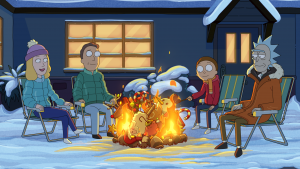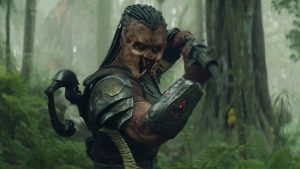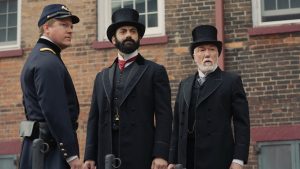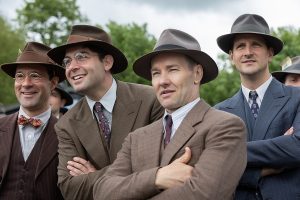
Star Wars Outlaws is a difficult game to judge. At once, it’s the franchise’s first open-world game, allowing you to freely explore multiple planets as well as the dangerous pockets of space around them on your trusty ship the Trailblazer. It’s the type of experience fans have waited years for, and Outlaws perfectly captures the tone and look of the galaxy far, far away, even expanding on things about the Star Wars underworld only hinted at in the movies and TV series. At its very best, this game is a celebration of decades of worldbuilding that almost feels like you’re living out your own Star Wars movie.
But at the same time, the experience is wrapped up in the well-trodden Ubisoft open-world formula and the problems that come with it. It’s a shame that the first Star Wars game of this caliber—the first modern game to let you really run wild through the lawless Outer Rim—stops short of ever innovating or doing anything particularly new. Instead, players are met with a repetitive gameplay loop that, while fun most of the time, hardly feels surprising or fresh in 2024. If you’ve ever played an Assassin’s Creed game or FarCry, the setup of Star Wars Outlaws simply won’t wow you.
In short, in terms of gameplay, Star Wars Outlaws feels a bit safe in its design. But the game is also hard to top in terms of sheer Star Wars nerdery. Its worldbuilding is magic, down to the scum and villainy that populate the five worlds that make up the game. There are so many fun Star Wars stories and characters to discover during your adventure as up and coming scoundrel Kay Vess that you can almost overlook the game’s many shortcomings. A clear love of Star Wars lore, combined with the game’s stellar Reputation system, makes for an overall satisfying first outing for developer Massive Entertainment in this universe.
The Good, the Bad, and the Repetitive
A Star Wars story is only as good as its central characters. While Kay Vess perhaps won’t go down as the most memorable scoundrel in Star Wars history, actor Humberly Gonzalez does bring plenty of charm to the Han Solo type. There’s a swagger and humor to Kay that’s hard not to like, even if it’s clear Massive is following the classic scoundrel blueprint from beginning to end.
The problem is that, in creating a protagonist on which players can project themselves, Massive has made Kay too much of a blank slate. Perhaps it’s the abrupt way we meet Kay at the start of the game—already a thief looking for her next big score in her hometown of Canto Bight, we don’t really learn much about her at the outset—or the fact that so much of the setup of the story leans on (again) well-worn crime movie tropes. That next big score? It obviously goes terribly wrong and now Kay has a huge price on her head and is on the run. The only thing she can do to save herself is recruit a team of thieves to pull off an even more dangerous heist that will surely get them all killed. You’ve heard this story before. Again, Ubisoft doesn’t reinvent the wheel.
There’s also a tonal dissonance between who Kay is meant to be in the story—a small-time thief who is still earning her stripes in the underworld and who, we’re told, is in way over her head—and the player’s actions in the game. It feels sort of jarring to see Kay nervously navigating a meeting with a big time crime boss when just a few minutes ago she was mowing down a platoon of stormtroopers in an Imperial base.
As far as the latter goes, Star Wars Outlaws is a solid third-person shooter experience, with a couple of neat tricks that keep early action sequences interesting. Kay’s blaster can shoot both plasma and ion bolts and you switch between the two modes to take down criminal thugs and stormtroopers with the former and droids and security cameras with the latter. A later function you unlock, a power blast you charge up before firing, is particularly good against groups of enemies as well as accessing secret areas.
Unfortunately, a few hours into the game, action sequences—as well as the stealth missions that usually precede firefights—start to feel pretty repetitive. After your second or third infiltration of an Imperial base or bandit camp, it’ll be difficult not to notice the same basic template for each sequence. A combination of platforming, taking down enemies from behind, sneaking through vents, unlocking doors via a particularly annoying rhythm puzzle, and hacking terminals is about as good as it gets in terms of stealth, and once things inevitably kick off and laser bolts start flying, explosive red barrels that quite conspicuously litter most areas help you make quick work of advancing enemies. (The red barrels feel like a particularly dated design choice.)
That said, Kay does have one other trick up her sleeve, and it’s easily one of the best parts of the game: her pet companion and partner in crime Nix. This adorable little guy not only provides a stronger emotional core for the story than most everything else we really learn about Kay’s past—seriously, there’s a part in this game where Nix’s life is in grave danger and Kay immediately goes to WAR to save him—but he’s also an indispensable extension of Kay when it comes to stealing things, distracting baddies, and sneaking. Nix can access certain areas that Kay physically can’t and you can even have him sabotage alarms or detonate the several hundred explosive barrels in the game. He does it all while also being cute as hell and imbuing scenes with so much personality. It’s clear Massive really put in the work to make players fall in love with Nix and he’s easily one of my favorite video game companions of all time.
ND-5, the enforcer droid tasked with protecting you/making sure you follow through on a deal you make at the start of the game, also brings his own interesting story to tell. Voiced by Jay Rincon, ND is the more serious and hardened criminal of the main trio, but along the way also reveals some emotional depth as he inevitably begins to soften towards Kay and Nix. ND trying to be “nice” also leads to some of the more comedic moments in the story.
Tales from the Mos Eisley Cantina
After everything goes wrong for Kay on Canto Bight, she ends up on the moon of Toshara, which is an original creation for the game. The moon is a combination of familiar open-world biomes—mostly canyons, rivers, caves, and grassy plains—that is initially presented as the “tutorial world” where Kay learns the ins and outs of working for different crime syndicates (the Pykes and Crimson Dawn that rule over Toshara), unlocking upgrades for her weapons and vehicles, and where she eventually receives her main mission (the aforementioned big heist). Because it’s meant to be the most beginner friendly, it’s also the world that feels the most video game-y, not quite as cinematic or immersive as all the rest.
That said, Mirogana City, the moon’s main city area that’s carved out of a giant cliff, is beautifully realized, visually stunning, and brimming with life, including many of your favorite alien races from the movies—Rhodians, Weequay, Aqualish, Mon Calamari, Quarrens, Twi’leks are all accounted for, and that’s before you even run into the Hutts, Gamorreans, Jawas, Sullustans, Ithorians, and Tusken Raiders. The game feels properly a part of the Original Trilogy era—recreating the feeling of stepping into the Mos Eisley cantina for the very first time at a much larger scale—which makes sense since the story takes place between The Empire Strikes Back and Return of the Jedi, with a few other races from the Prequels and Sequels as an added bonus.
Once you’re off Toshara—after learning how to properly pilot your ship and fight off enemy ships in dogfights that unfortunately don’t really scratch that arcade shooter Rogue Squadron itch so many of us ‘90s kids still have—you head to far more recognizable locations, including the galaxy’s most important desert moon.
Tatooine is where the game really clicks, which is pretty wild considering most of it is just desert, with a few settlements scattered across the map, including the iconic Mos Eisley. But it’s on that rock farthest from the bright center of the universe that the game really captures the space western feel that made the original films so special, down to the gunslingers, scavengers, and bandits that populate the planet.
Each planet has its own main story to tell and Tatooine’s in particular kicks things into high gear quickly, leading to a tense encounter inside Jabba’s Palace, an absolute highlight of the game. Few things feel more properly cinematic in Star Wars Outlaws than approaching the towering palace from Return of the Jedi, and the feeling is heightened by the fact that you’re actually there to break into it. It’s one of the game’s most captivating missions, and as you’d expect, it’s full of nods to the movies as well as a few cameos.
Tatooine really captures the best of the Star Wars Outlaws experience in a nutshell, making you feel like you’ve stepped into your own Expanded Universe adventure, providing the nostalgia you’d expect while also expanding on things only hinted at on the big screen. Lore-obsessed fans might liken the feeling of stepping onto Tatooine, crossing paths with Jawas, Hutts, and Tuskens, and exploring Mos Eisley—including the infamous cantina, of course—to reading Star Wars books from the ‘90s, particularly the Tales anthologies that fleshed out so much of the underbelly of George Lucas’ world at a time when there weren’t any new movies in theaters.
It’s a similar feeling when you land in snowy Kijimi, a newer creation from The Rise of Skywalker, or the wild jungles of Akiva, a planet that was actually first introduced in the Star Wars Aftermath books. There are plenty of little stories to find as you make your way through the different settlements and cities in the game as well as references to bigger events happening in the periphery of your story. Yes, you’ll run into a few Rebels along the way, there’s still a civil war going on, after all.
Most importantly, each world feels distinct from the next, with Kijimi’s temples hinting at an ancient origin and religion while Akiva’s untamed jungles are thick with wildlife—there are actually lots of animals scurrying and flying around these planets, a nice touch that helps the environments feel just a tad more immersive.
Reputation Is Everything
What ties all of these worlds together, of course, are the crime syndicates that rule them and the game’s best feature: the Reputation system. If Star Wars Outlaws excels at one thing, it’s making you feel like many of your decisions matter.
To progress through the game, you’ll have to pick up work from the four main crime families of the Outer Rim: the Pykes, Crimson Dawn, the Hutt Cartel, and the Ashiga Clan. Many of these quests are story-driven, although there are other (admittedly more repetitive) side contracts that may task you with planting listening devices, stealing data, recovering lost cargo in space, or making a delivery before a timer runs out. But both story-driven and contract jobs are rarely as clear cut as completing them as intended for your shady employers and moving on to the next one.
Kay’s criminal escapades often lead to a choice between following through on your deal with the syndicate that hired you or double-crossing them to the benefit of an opposing crime family. Your decision will very likely be driven by your standing with each group at any given time. Having a Good to Excellent rating with a criminal syndicate can make your life a lot easier when trying to access their territories or dealing with their merchants and brokers. The better the relationship the better access you get to contracts and other unlockables and upgrades. But if you’re in Poor, Bad, or Terrible standing with any of these syndicates, they’re likely to shoot at you as soon as they spot you, or in the case of the worst rating, send out thugs to eliminate you.
The balancing act between keeping all these syndicates happy—or at least keeping them from trying to kill you—is a tight-rope walk at the best of times that really makes you feel like a scoundrel navigating the underworld. If you’ve ever wondered what it might be like to be Han Solo trying to talk Jabba out of putting a bounty on his head, I don’t know another game that comes as close to letting you role-play that experience.
Worth a Sequel?
Ultimately, Star Wars Outlaws can’t quite escape many of the issues that continue to haunt Ubisoft’s all too familiar open-world game design, including the bugs and repetitive filler content. Tighter controls all around would also be nice—seriously, it can be difficult to find the right angle to interact with certain objects in the environments at times.
But beyond the technical, it’s clear that Massive has put a lot of love into building out the lore of their video game galaxy. Outlaws truly feels like Star Wars, down to the smaller details, like the Kowakian monkey-lizards that taunt you, the crooks who will try to rip you off with tempting offers, the greebles on ships, the crooked Imperial officers with side hustles, the sabacc games you’ll find at the local watering holes, and the datapads that refer back to other parts of galactic history. If you’re a longtime Star Wars nerd, it’s a lot of fun just walking around the different places in the game to see what little references and stories you might find next.
Kay, while not quite as fleshed-out as past Star Wars video game protagonists, also has the potential to become one of the great scoundrels in the franchise if given more time to cook, and I’d love to see more of this seedy corner of the galaxy far, far away through her eyes down the line. There are plenty of things in the Star Wars Outlaws experience that need to be refined, but Massive has more than earned another go at this universe in the future.
The post Star Wars Outlaws Is a Love Letter to Star Wars Canon (With a Few Big Problems) appeared first on Den of Geek.






